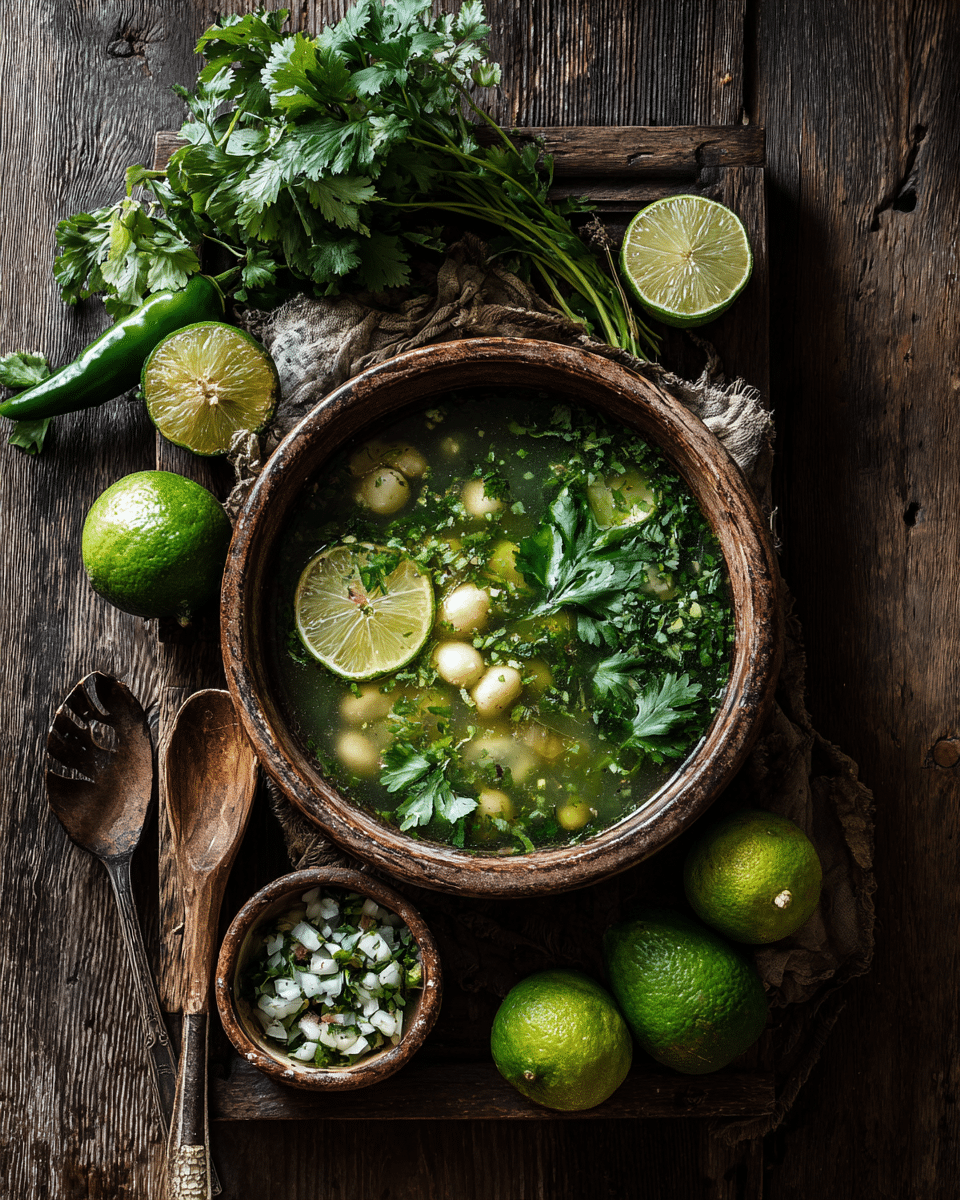Pozole is a traditional Mexican soup that is especially popular during festive occasions such as Independence Day celebrations. This hearty and flavorful dish centers around hominy (dried corn kernels treated with an alkali), combined with tender meat and richly seasoned broth. Pozole comes in different regional variations, with the two most popular being Pozole Verde, made with a green tomatillo and herb-based sauce, and Pozole Rojo, characterized by its bold red chili flavor.
FULL RECIPE
Ingredients
1.For Pozole Verde:
- 2 pounds pork shoulder, cut into chunks
- 1 onion, quartered
- 4 cloves garlic
- 8 cups water
- 2 cans (29 oz each) white hominy, drained and rinsed
- 1 pound tomatillos, husked and rinsed
- 1 bunch cilantro
- 3 serrano or jalapeño peppers, stemmed and seeded for less heat
- 1/2 cup chopped green onions
- 1 teaspoon dried oregano
- Salt to taste
2.For Pozole Rojo:
- 2 pounds pork shoulder, cut into chunks
- 1 onion, quartered
- 4 cloves garlic
- 8 cups water
- 2 cans (29 oz each) white hominy, drained and rinsed
- 5 dried guajillo chilies, stemmed and seeded
- 3 dried ancho chilies, stemmed and seeded
- 1 teaspoon cumin
- 1 teaspoon dried oregano
- Salt to taste
3.Common Garnishes:
- Shredded cabbage or lettuce
- Radish slices
- Diced white onion
- Fresh cilantro leaves
- Lime wedges
- Avocado slices
- Tostadas or tortilla chips
Directions
- Cook the Pork: In a large pot, combine pork shoulder, onion, garlic, and water. Bring to a boil, then reduce heat and simmer gently until pork is tender, about 2 hours. Skim off any foam that rises to the surface. Remove pork and shred it; reserve broth.
- Prepare Hominy: Drain and rinse the canned hominy. Add hominy to the reserved broth and simmer for 20 minutes to heat through.
- For Pozole Verde:
3. Boil tomatillos, cilantro, green onions, and peppers in water until soft, about 15 minutes. Drain and blend until smooth. Add this green sauce to the pot with hominy and pork. Stir in oregano and salt, and simmer for another 30 minutes to let flavors meld. - For Pozole Rojo:
3. Toast guajillo and ancho chilies lightly in a dry skillet until fragrant, then soak in hot water for 20 minutes. Blend soaked chilies with some pork broth until smooth. Add chili sauce to the pot with hominy and pork. Stir in cumin, oregano, and salt. Simmer for 30 minutes. - Serve: Ladle pozole into bowls and offer garnishes such as cabbage, radish, onion, cilantro, lime, and avocado for guests to customize their soup.
Nutrition Facts
- Calories: 420
- Protein: 35g
- Fat: 18g
- Saturated Fat: 6g
- Carbohydrates: 30g
- Fiber: 7g
- Sugars: 4g
- Cholesterol: 90mg
- Sodium: 600mg
Historical Roots of Pozole
Pozole is a dish with deep historical significance that dates back to pre-Hispanic Mexico. Originally, pozole was prepared by indigenous peoples using hominy and wild meats, sometimes in ceremonial contexts. After the Spanish conquest, pork became the preferred protein, blending indigenous and European culinary traditions. Today, pozole is a symbol of Mexican heritage, often enjoyed during national celebrations such as Independence Day, connecting modern diners to centuries of cultural history.
Differences Between Pozole Verde and Pozole Rojo
The two most popular types of pozole, verde and rojo, are distinguished primarily by their base sauces and regional preferences. Pozole Verde features a bright green broth made from tomatillos, cilantro, and green chilies, giving it a fresh, tangy flavor. Pozole Rojo uses dried red chilies like guajillo and ancho, resulting in a deep, smoky, and slightly spicy broth. Both variants highlight hominy and pork but deliver uniquely different taste experiences that appeal to a wide range of palates.
Flavor Profile and Texture
Pozole is celebrated for its rich, hearty flavors balanced by fresh, crisp toppings. The broth is savory and aromatic, with the hominy adding a subtle sweetness and chewy texture. The slow-cooked pork lends tenderness and depth, while the green or red sauces infuse the soup with distinct herbal or smoky notes. The garnishes—cabbage, radishes, lime, and avocado—add crunch and brightness, creating a multi-textured dish that is comforting yet vibrant.
Nutritional Benefits
While pozole is often enjoyed as a celebratory meal, it offers considerable nutritional value. The pork provides a robust source of protein and essential vitamins like B12. Hominy contributes complex carbohydrates and dietary fiber, aiding digestion and sustained energy. The herbs and fresh garnishes add vitamins, antioxidants, and minerals. However, due to the richness of the broth and meat, it is relatively high in calories and fat, so portion control is key for those watching their intake.
Regional and Ingredient Variations
Across Mexico, pozole has many variations reflecting local ingredients and tastes. In some regions, chicken replaces pork, while others use beef or even seafood. The choice and quantity of chilies or herbs can vary, changing the spice level and flavor profile. Some recipes include additional vegetables or spices such as cumin or Mexican oregano. These adaptations demonstrate the dish’s flexibility and enduring popularity across diverse communities.
Serving Suggestions and Garnishes
Pozole’s hallmark is the customizable toppings that diners add according to preference. Common garnishes include shredded cabbage or lettuce for crunch, thinly sliced radishes for a peppery bite, fresh cilantro for herbaceous notes, diced onion for sharpness, and lime wedges for acidity. Creamy avocado slices and crispy tostadas or tortilla chips are also popular. These accompaniments allow each person to tailor the dish to their taste, enhancing both flavor and texture.
Pairing Pozole with Drinks and Side Dishes
Pozole pairs wonderfully with traditional Mexican beverages and sides. Agua frescas like hibiscus or tamarind provide a refreshing counterpoint to the hearty soup. Mexican beer or a light white wine complements the flavors without overwhelming the palate. Side dishes such as warm corn tortillas, refried beans, or a simple salad round out the meal, creating a well-balanced dining experience perfect for festive gatherings.
Common Preparation Challenges and Tips
Preparing pozole requires attention to timing and technique to develop deep, complex flavors. Slow-cooking the pork until tender is essential, as is ensuring the hominy is properly cooked and tender without becoming mushy. Blending the sauces for verde or rojo pozole demands balancing heat and acidity. To avoid bitterness or over-spicing, soaking dried chilies and carefully adjusting seasoning is recommended. Planning and patience result in a richly flavored, satisfying soup.
Storage and Reheating Guidelines
Pozole keeps well when stored properly and can be a great make-ahead dish for celebrations. Leftover soup should be refrigerated in airtight containers and consumed within 3 to 4 days. The hominy may absorb liquid over time, so broth might need thinning when reheating. Gently warm pozole on the stove to preserve texture and flavor. Fresh garnishes are best added only at serving time to maintain their crispness and freshness.
Cultural Importance During Festivities
Pozole plays a vital role in Mexican festive traditions, especially during Independence Day and Christmas celebrations. Preparing and sharing pozole is often a communal activity, fostering togetherness among family and friends. It is a dish that embodies hospitality and pride, enjoyed not only for its taste but also for its cultural symbolism. Its presence at the table signals joy, heritage, and the continuation of cherished culinary customs.
Advertisement
Modern Adaptations and Dietary Alternatives
In response to contemporary dietary preferences, pozole has seen creative adaptations. Vegetarian and vegan versions substitute pork with mushrooms, jackfruit, or soy-based proteins, while maintaining traditional flavors through herbs and chilies. Gluten-free options are naturally available since hominy and meat are free of gluten. Health-conscious cooks may reduce sodium or fat content by trimming meat or modifying the broth. These innovations allow pozole to remain relevant and accessible to diverse diets without losing its essence.
Conclusion
Pozole Verde and Rojo are more than just soups they are a vibrant expression of Mexico’s rich culinary tapestry and cultural heritage. From its ancient roots to modern variations, pozole continues to bring people together in celebration. Its comforting, layered flavors and interactive garnishes create a communal eating experience cherished across generations.






